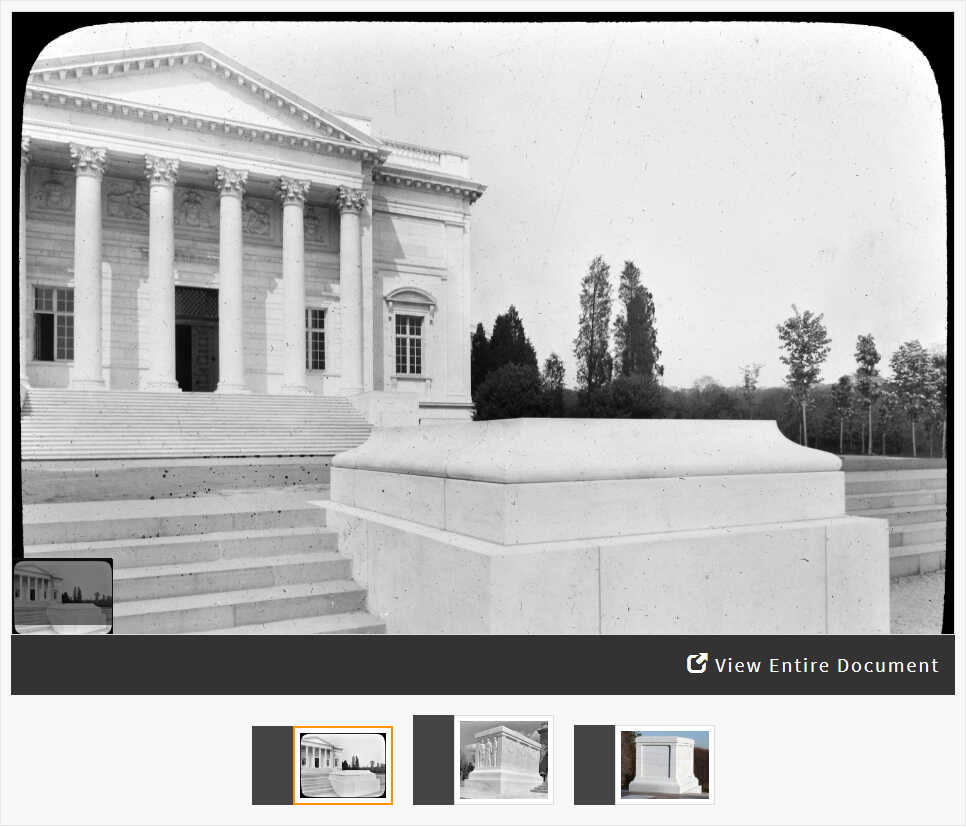This activity introduces students to the idea of tombstones being used throughout history to remember people who have died. Students are asked to perceive and describe elements of art (such as shape, material, and symbols) in the Tomb of the Unknown Soldier. They will compare and contrast an earlier version of the memorial with an updated version, identify their feelings about each version, and brainstorm reasons why Congress wanted to update the design.
Suggested Teaching Instructions
Use this activity while teaching about symbolism, photograph analysis, artwork or sculpture analysis, or to connect to Veterans Day. For grades 4-8. Approximate time needed is 30 minutes. It is recommended for a full-class setting, with an option for working individually or in pairs during a portion of the activity.
Students will see three different photographs of the Tomb of the Unknown Soldier. The first shows the monument as it looked in 1921 when it was a simple marble slab. The second and third photographs show it in 1932 after Congress had authorized its completion and a superstructure was placed on top.
Before beginning the activity, ask students to speak about their experience with tombstones:
- Have you ever visited a cemetery?
- From what type of material are tombstones typically made? Why is this a good material to use?
- What decorations are commonly found on tombstones? How do the words and images make you feel?
After discussing their answers, share the following background information with students:
Throughout history, tombstones have been one common way that people have remembered deceased friends and family members. They are memorial monuments – that is, sculptures that commemorate a person or group of people who died in the past.
Arlington National Cemetery near Washington, DC, is a memorial site honoring active-duty servicemembers, veterans, and their families. There are more than 300,000 tombstones commemorating individuals from every American conflict, from the Revolutionary War to the present day.
With more than 100,000 American casualties from World War I, the United States faced an unprecedented challenge as many soldiers' bodies could not be identified. In 1921, three years after the war ended, the U.S. government built a memorial to honor an unknown soldier, who would be buried in Arlington National Cemetery and represent all of the unnamed servicemembers who sacrificed their lives during WWI. This monument is called the Tomb of the Unknown Soldier.
Project the first photograph in the activity, of the Tomb of the Unknown Soldier in 1921, for the entire class to see. Share with students that:
On November 9, 1921, the unknown soldier arrived in Washington, D.C. and lay in state at the U.S. Capitol Rotunda, where about 90,000 visitors paid their respects the following day. On November 11, 1921, a procession carried the unknown soldier to Arlington National Cemetery. President Warren G. Harding then led a state funeral ceremony and placed the Medal of Honor, the nation's highest military decoration, on the casket.
Using the first photograph, model artwork analysis techniques for students. Use vocabulary to describe elements of art, such as color, line, shape, and texture. Ask students to identify key features and assess their feelings about what they see. Noting that the Tomb of the Unknown Soldier is a tombstone, ask them to think about how it is similar or different from graves at cemeteries they have been to or seen. What challenges might the sculptor have faced in designing a memorial for someone he did not know?
Next, click on the second and third photographs to show students the superstructure that was added to the Tomb in 1932. Explain that:
More than 10 years after the Tomb of the Unknown Soldier was created, Congress (the part of the government that makes laws and decides how to spend government money) authorized its completion. Architect Lorimer Rich and sculptor Thomas Hudson Jones created a new "superstructure" that was placed on top.
Ask students to take a minute to examine the monument as it looked in 1932, then to work individually, in pairs, or as a full class to answer the questions that follow, which will guide them through the analysis process:
- What images and words are used on this memorial? How do they make you feel?
- What challenges might the sculptor have faced in designing a memorial for someone he did not know?
- Is there symmetry and/or repetition in the design? Are its parts proportional to one another?
- Is there a sense of movement?
- What colors are used?
- Which design do you like better? Why?
Students may note the inscription: "Here Rests in Honored Glory an American Soldier Known but to God." They may also note the memorial's neoclassical style, reminiscent of ancient Greece or Rome, that includes three wreaths on long sides of the Tomb, three figures on the East panel, and clothing that does not appear contemporary. You can ask students who they think the figures symbolize, or you can share that the artist intended them to represent Peace, Victory, and American Manhood (later changed to Valor).
Follow up with a class discuss about students' answers to the questions, then direct them to click on "When You're Done" to respond to:
- Brainstorm two or three reasons why Congress might have wanted to update the memorial design in 1932. What clues from the photographs help support your ideas?





